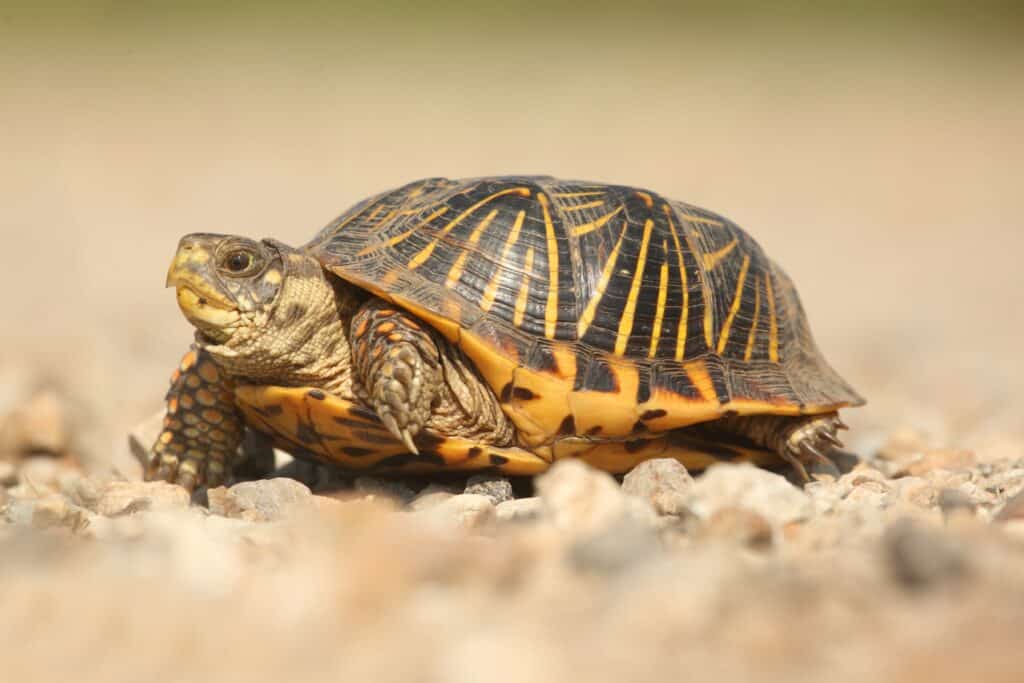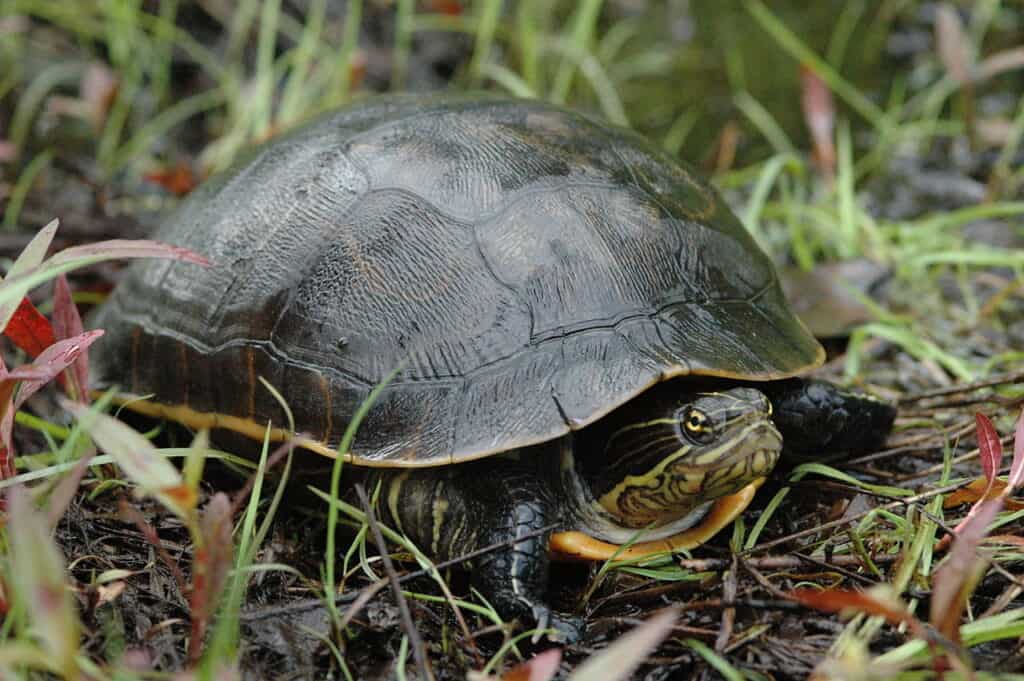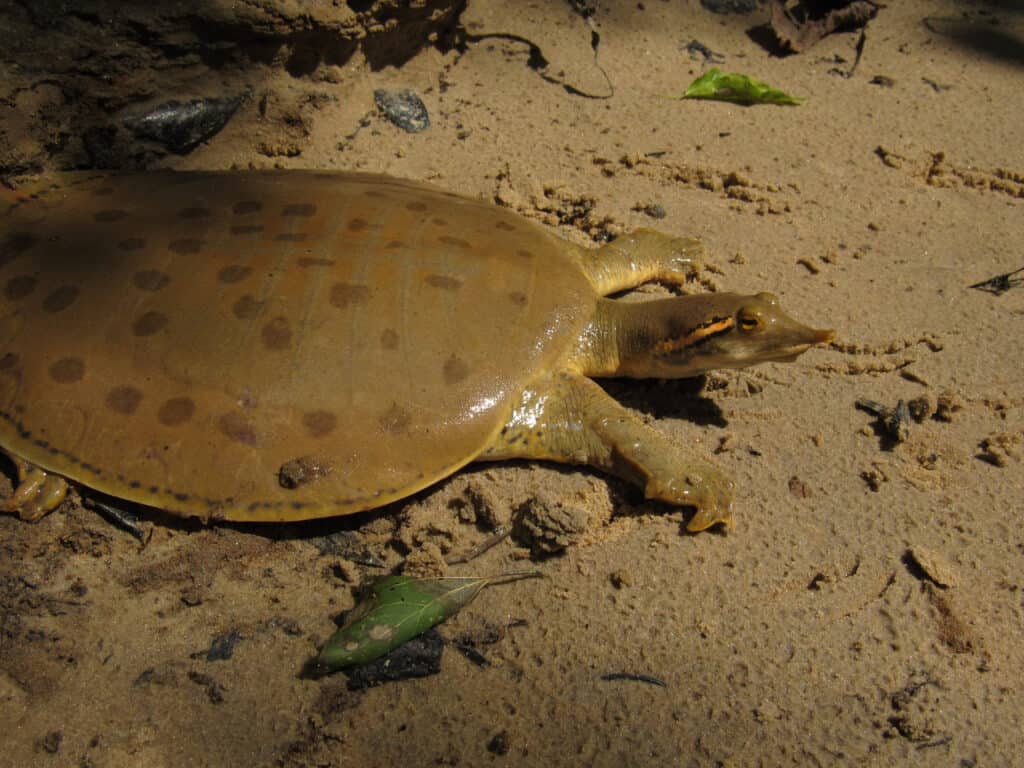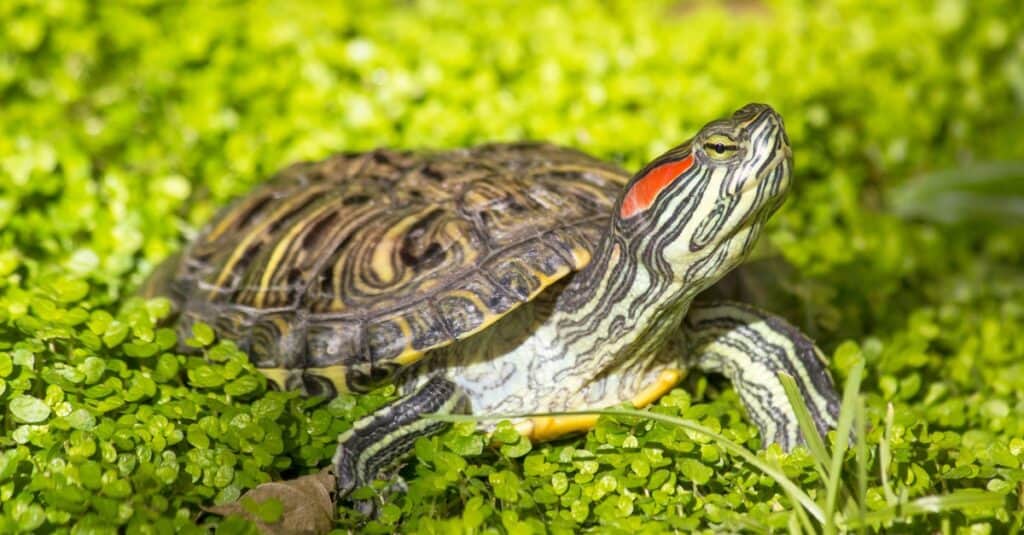Oklahoma, also known as the Sooner State, is home to around 17 different species of turtles. Most of these turtles are aquatic or at least semi-aquatic, though a couple of mostly terrestrial species reside there, too! This unique state is surprisingly geographically diverse, which lends itself to an equally impressive amount of biodiversity. In particular, its shelled reptiles vary greatly in size, shape, color, diet, and more. Let’s take a closer look at 8 of the most incredible turtles in Oklahoma below.
1. Ornate Box Turtle (Terrapene ornata ornata)

Ornate box turtles are a subspecies of the western box turtle
©Steve Byland/Shutterstock.com
The ornate box turtle is one of Oklahoma’s few terrestrial turtle species, which simply means it spends most of its time on land rather than in water. Like all other box turtles, the ornate box turtle has a double-hinged belly shell, or plastron. This helpful defense mechanism allows it to tightly seal itself into its rigid shell as if it were an armored box!
The typical ornate box turtle is around 4 to 6 inches long, with males being slightly smaller than females. However, males have longer, thicker tails and reddish eyes, while the females’ eyes are usually brown. Its carapace is tall, brown, and dome-shaped with bright yellow lines on each individual scute. The turtle’s skin is similarly greyish-brown but usually has yellow markings, particularly around the limbs and neck.
This subspecies of the western box turtle lives throughout Oklahoma and is most common in the western half of the state. Its geographic range also covers most of Texas, Nebraska, and Arkansas. It prefers open prairie habitats with scattered brush and soft, sandy soil. Though it is terrestrial, it always lives near a freshwater habitat like a pond, lake, or stream.
2. Alligator Snapping Turtle (Macrochelys temminckii)

An Alligator snapping turtle on the road. Alligator snapping turtles sometimes prey on smaller snapping turtles.
©Sista Vongjintanaruks/Shutterstock.com
Like an alligator, the alligator snapping turtle has an incredibly fast, powerful, and painful bite. Its most unique trait, however, is its vermiform (meaning “worm-shaped”) tongue that it uses to lure in prey like fish and frogs!
As one of the largest freshwater turtle species, alligator snapping turtles vary in size from around 30 to 50 pounds on average but can weigh over 200 pounds in rare cases! They’re also quite long, ranging from 13 to 30 inches on average. The top portion of its shell, the carapace, is extremely craggy and textured with raised, pyramid-shaped scutes. Because it spends so much of its time sitting motionless, partially submerged, and waiting for prey to wander into its mouth, its carapace is also often covered in a thick layer of green algae.
While the top half of this turtle’s shell is very large, the bottom half, the platron, is significantly reduced in size. This gives its muscular legs and large, clawed feet a better range of mobility than most other aquatic turtles. Thanks to its fearsome bite, speedy and aggressive nature, and massive size, it has almost no natural predators!
The alligator snapping turtle’s geographic range covers most of the US’ Gulf Coast area, including most of Louisiana, Alabama, Mississippi, and Arkansas. It can also be found throughout eastern Oklahoma. It prefers freshwater swamps and marshes with lots of plant cover, but it can also tolerate brackish water.
3. Mississippi Map Turtle (Graptemys pseudogeographica kohnii)

Mississippi map turtles are distinguished by the raised keel down the middle of their carapace
©iStock.com/Artur Bogacki
The Mississippi map turtle is a subspecies of the false map turtle. Its scientific name is in honor of naturalist Joseph Gustave Kohn, who collected and named the first type specimen.
One of this species’ most prominent traits is the raised central ridge, or keel, stretching lengthwise down the center of its carapace. In addition, the scutes, or individual scales, along the rear edges of the carapace have a jagged or serrated appearance. It averages 3 to 10 inches in length, with females being much larger than males.
Like most map turtles, its carapace is dark brown with lots of thin, wavy, lighter brown or yellowish lines throughout (like contour lines on a map!). It has dark green and yellow striped skin with a large yellow mark behind the eyes.
Also similar to other map turtle species and subspecies, the Mississippi map turtle is highly aquatic and a strong swimmer. It prefers freshwater habitats like rivers, streams, and lakes. It can mainly be found along the Mississippi River and throughout eastern Oklahoma.
4. Yellow Mud Turtle (Kinosternon flavescens)

The yellow mud turtle has yellow markings around its throat
©Kayla Blundell/Shutterstock.com
The yellow mud turtle gets its common name from the yellow markings around its throat and chin. It is also sometimes known as the yellow-necked mud turtle for this same reason. Similarly, its scientific name, flavescens, translates to “yellow” in Latin.
This species has a very rounded, oval-shaped carapace that ranges from yellowish brown to greyish-brown in color. Its skin is almost entirely greyish-tan except for the yellow markings around its throat and chin. On average, it ranges from 4 to 5 inches long, and its webbed feet are very large for its body size. Its plastron is usually a lighter yellow and hinged similar to those of box turtles. Notably, males of the species have a spine on their tails, while females lack said spine.
The yellow mud turtle can be found primarily in western Oklahoma. It prefers freshwater lakes and ponds with muddy bottoms and lots of aquatic vegetation. Its geographic range covers most of Texas, western Kansas, and eastern New Mexico in addition to part of northern Mexico.
5. Eastern River Cooter (Pseudemys concinna concinna)

Eastern river cooter is one of the largest freshwater turtles in Oklahoma
©NasserHalaweh / CC BY-SA 4.0 – License
This subspecies of the river cooter is one of Oklahoma’s largest freshwater turtles. Although it averages 9 to 13 inches long, some individuals have been recorded measuring more than 16 inches long!
This highly aquatic species almost never leaves the water. Its somewhat flat, dark greenish-brown carapace has yellow line or webbing-like markings throughout, while its plastron is yellow to orange in color with a dark brown outline on each individual scute. The rear edges of its carapace flare slightly upwards. Generally, females are larger than males. Its skin is dark green with bold yellow striping throughout.
The eastern river cooter lives throughout much of eastern and central Oklahoma. It can also be found throughout the southern Midwest and Southeast US as far north as Virginia and as far south as central Florida. It is herbivorous and prefers freshwater lakes and rivers with lots of aquatic vegetation to feed on.
6. Western Chicken Turtle (Deirochelys reticularia miaria)

The western chicken turtle is a subspecies of the chicken turtle
©Virginia State Parks staff / CC BY 2.0 – License
The western chicken turtle is one of three subspecies of the chicken turtle (in addition to the eastern and Florida varieties). Additionally, it is the smallest of the three subspecies, ranging from 6 to 10 inches long on average. Its common name comes from the alleged taste of its meat, which was commonly used to make turtle soup in the 1700s and 1800s.
Despite its fairly modest size, this species has an impressively long neck! Another notable trait is its greenish-brown carapace, which typically has a yellow rim or border around the edges. The underside of its shell, the plastron, is similarly yellow, though it also sometimes has darker spots of color. Its dark green skin has bright yellow stripes, particularly around the legs. The rear half of its shell is slightly wider than the front half.
The western chicken turtle can mainly be found west of the Mississippi River around the Gulf Coast area. Its geographic range covers most of Texas and Louisiana and extends north into Oklahoma, Missouri, and Arkansas. It prefers still or slow-moving freshwater ponds, lakes, and marshes with muddy bottoms and aquatic vegetation.
7. Smooth Softshell Turtle (Apalone mutica)

Softshell turtles have a smooth carapace
©Gabbie Berry/Shutterstock.com
True to its name, the smooth softshell turtle has a perfectly flat, smooth, leathery-soft shell with no individual scales (also known as scutes).
Although most softshell turtle species look mostly the same, the smooth variety can be differentiated from the rest by its rounded nostrils. This is because all other softshell species have C-shaped nostrils! It also notably lacks the tiny cone-shaped spines present on the spiny softshell’s carapace.
Aside from its bizarre-looking shell, this species can quickly be identified by its very long, narrow snout. Both its skin and shell are a drab olive green to dark brown in color. It has large, webbed feet and a long, flexible neck for its size. On average, it ranges from around 5 to 14 inches long, with females being much longer and larger than males.
This amazing turtle is highly aquatic–in fact, it’s the most aquatic of all softshell turtle species! Generally, it prefers freshwater habitats with sandy bottoms and very little vegetation. It can tolerate fast-moving currents, but it also commonly lives in still or slow-moving habitats like ponds and marshes. You can find the smooth softshell turtle throughout Oklahoma, and its geographic range covers most of the Midwest and scattered areas of the eastern US.
8. Red-Eared Slider (Trachemys scripta elegans)

Red-eared slider sitting on a bed of pond grasses. These pond turtles have poor hearing but good vision and are very sensitive to vibrations.
©xbrchx/Shutterstock.com
The red-eared slider is well-known for two main reasons: first, it is one of the most popular turtle species in the exotic pet trade, and second, it is the world’s most invasive turtle species. Like its common name implies, the red-eared slider has large red splotches behind its eyes, which makes it easy to differentiate from other pond slider turtles.
The typical red-eared slider’s carapace ranges from olive green to greenish-brown with thin yellow markings. The underside of the shell, the plastron, is yellowish and often has small, irregular green splotches. Aside from the red markings near its “ears,” its skin is dark green with bold yellow striping throughout. It averages 5 to 10 inches in length, but in rare cases, it can reach more than 15 inches long!
This handsome species has a pretty massive geographic range, covering most of the lower Midwest, Gulf Coast area, and much of the eastern half of the United States in general. Red-eared slider turtles can be found throughout Oklahoma, primarily in warm, shallow, slow-moving or still freshwater habitats. It prefers habitats with lots of vegetation, rocks, and logs nearby for basking.
Up Next:
The photo featured at the top of this post is © Steve Byland/Shutterstock.com
Thank you for reading! Have some feedback for us? Contact the AZ Animals editorial team.







